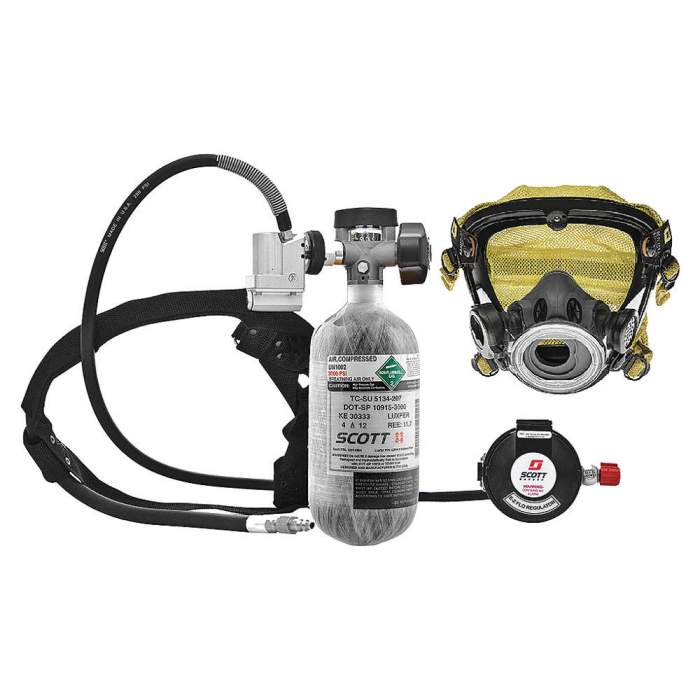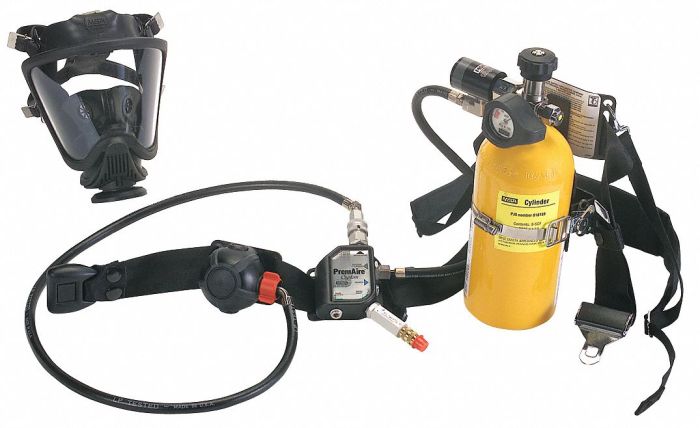The NIOSH-approved type-C full facepiece supplied air respirator stands as a beacon of respiratory protection, offering unparalleled safety and reliability in hazardous environments. Its innovative design and meticulous construction ensure the highest level of protection, making it an indispensable tool for workers in various industries.
This comprehensive guide delves into the intricacies of this respirator, exploring its design, operation, maintenance, applications, limitations, safety considerations, industry standards, and best practices. Through a combination of in-depth analysis and practical insights, we aim to empower readers with the knowledge and understanding necessary to make informed decisions regarding respiratory protection.
NIOSH-Approved Type-C Full Facepiece Supplied Air Respirator Overview

A NIOSH-approved type-C full facepiece supplied air respirator (SAR) is a respiratory protective device that provides a continuous supply of clean, breathable air to the wearer’s face. It is designed to protect against hazardous substances, such as toxic gases, vapors, and particulates, that may be present in the workplace or environment.
Type-C SARs are typically used in industrial settings, such as chemical plants, refineries, and laboratories, where the concentration of hazardous substances exceeds the safe exposure limits. They are also used in emergency response situations, such as firefighting and hazardous materials spills.
Advantages of Using Type-C SARs
- Provides a high level of protection against a wide range of hazardous substances
- Continuous supply of clean air, eliminating the need for frequent filter changes
- Full facepiece design provides a wide field of vision and allows for the use of other personal protective equipment, such as safety glasses
- Can be used in conjunction with other respiratory protective equipment, such as air-purifying respirators, to provide additional protection
Disadvantages of Using Type-C SARs
- Can be bulky and uncomfortable to wear for extended periods
- Requires a constant supply of clean air, which may not be available in all situations
- Can be expensive to purchase and maintain
Design and Components

Type-C SARs consist of several key components:
- Facepiece:The facepiece is the part of the respirator that covers the wearer’s face. It is made of a flexible material, such as silicone or rubber, and is designed to fit snugly around the face to prevent leakage.
- Head harness:The head harness is used to secure the facepiece to the wearer’s head. It is adjustable to ensure a comfortable fit.
- Air supply hose:The air supply hose connects the facepiece to the air source. It is made of a flexible material, such as polyurethane or rubber, and is designed to withstand high pressure.
- Air source:The air source can be a compressed air cylinder, a portable air compressor, or a fixed air supply system. It provides a continuous supply of clean, breathable air to the facepiece.
- Regulator:The regulator is used to control the flow of air from the air source to the facepiece. It ensures that the wearer receives a constant supply of air at the correct pressure.
Operation and Maintenance

Proper operation and maintenance of a Type-C SAR is essential to ensure its effectiveness and safety. The following procedures should be followed:
Donning the Respirator
- Inspect the respirator for any damage or defects.
- Adjust the head harness to ensure a snug fit.
- Connect the air supply hose to the facepiece.
- Turn on the air supply and adjust the regulator to the desired flow rate.
- Place the facepiece over your face and ensure a tight seal.
Doffing the Respirator, Niosh-approved type-c full facepiece supplied air respirator
- Turn off the air supply.
- Disconnect the air supply hose from the facepiece.
- Remove the facepiece from your face.
- Inspect the respirator for any damage or contamination.
Cleaning the Respirator
The respirator should be cleaned and disinfected regularly to prevent the growth of bacteria and mold. The following steps should be followed:
- Disassemble the respirator into its component parts.
- Wash the facepiece, head harness, and air supply hose with a mild soap and water solution.
- Rinse the components thoroughly with clean water.
- Disinfect the components with a bleach solution or other appropriate disinfectant.
- Allow the components to air dry completely.
- Reassemble the respirator.
Applications and Limitations: Niosh-approved Type-c Full Facepiece Supplied Air Respirator

Type-C SARs are commonly used in the following applications:
- Chemical plants
- Refineries
- Laboratories
- Firefighting
- Hazardous materials spills
Type-C SARs are not suitable for use in the following situations:
- Oxygen-deficient atmospheres
- Environments with high levels of flammable gases or vapors
- Environments with high levels of heat or radiation
Helpful Answers
What industries commonly use NIOSH-approved type-C full facepiece supplied air respirators?
These respirators are widely used in industries such as construction, mining, manufacturing, and healthcare, where workers may encounter hazardous substances or environments.
What are the limitations of NIOSH-approved type-C full facepiece supplied air respirators?
These respirators are not suitable for use in environments with oxygen deficiency or where there is a risk of explosion or fire.
How often should NIOSH-approved type-C full facepiece supplied air respirators be inspected and tested?
Regular inspection and testing are crucial to ensure the respirator’s proper function and should be conducted according to the manufacturer’s recommendations.